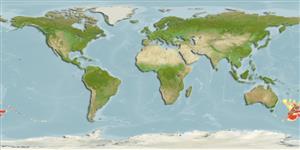Environment: milieu / climate zone / depth range / distribution range
Écologie
marin bathydémersal; profondeur 170 - 1460 m (Ref. 26346). Deep-water
Southwest Pacific: endemic to New Zealand.
Taille / Poids / Âge
Maturity: Lm ? range ? - ? cm
Max length : 80.0 cm TL mâle / non sexé; (Ref. 26346)
Description synthétique
Clés d'identification | Morphologie | Morphométrie
Dark brown in color (Ref. 26346). Wing tips rounded; snout shorter than most other skates; skin smooth, soft and loose, with band of prickles on hind body and tail (Ref. 26346).
Inhabits the continental slope (Ref. 26346). Oviparous (Ref. 50449). Eggs have horn-like projections on the shell (Ref. 205).
Life cycle and mating behavior
Maturité | Reproduction | Frai | Œufs | Fécondité | Larves
Oviparous (Ref. 26346). Paired eggs are laid. Embryos feed solely on yolk (Ref. 50449).
McEachran, J.D. and K.A. Dunn, 1998. Phylogenetic analysis of skates, a morphologically conservative clade of elasmobranchs (Chondrichthyes: Rajidae). Copeia 1998(2):271-290. (Ref. 27314)
Statut dans la liste rouge de l'IUCN (Ref. 130435: Version 2024-1)
Menace pour l'homme
Harmless
Utilisations par l'homme
Outils
Articles particuliers
Télécharger en XML
Sources Internet
Estimates based on models
Preferred temperature (Ref.
123201): 7 - 10.1, mean 8.5 °C (based on 72 cells).
Phylogenetic diversity index (Ref.
82804): PD
50 = 0.5039 [Uniqueness, from 0.5 = low to 2.0 = high].
Bayesian length-weight: a=0.00562 (0.00288 - 0.01097), b=3.11 (2.94 - 3.28), in cm total length, based on LWR estimates for this (Sub)family-body shape (Ref.
93245).
Niveau trophique (Ref.
69278): 3.9 ±0.7 se; based on size and trophs of closest relatives
Résilience (Ref.
120179): Faible, temps minimum de doublement de population : 4,5 à 14 années (Fec assumed to be <100).
Fishing Vulnerability (Ref.
59153): Moderate to high vulnerability (52 of 100).
